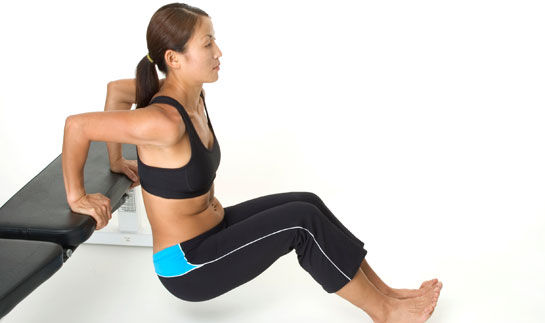
Q: In school they taught us to avoid [the dips] position because "there really is no prime mover for shoulder flexion." This position off the edge of a chair seems to put a heavy burden on the front shoulder flexors. —Robert Fernandez, responding to the “Best Triceps Exercises” study published in the August 2011 issue of ACE Certified News
A: Although dips are a functional movement, they are often considered controversial as an exercise due to the propensity for increased stresses across the anterior portion of the shoulder joint. The recent ACE-sponsored study compared eight traditional exercises for muscle activity using electromyography (EMG) data. The goal of the study was to examine muscle activation of the long and lateral heads of the triceps muscle to determine exercise efficacy. Although the traditional bench-dip exercise scored among the top three in eliciting muscle activity, it is important to note some study limitations prior to discussing the safety concerns associated with this exercise. While the researchers validated their study by standardizing their procedure [i.e., selecting experienced lifters with proper form, providing pre-testing regimen instructions, performing baseline one-repetition maximum (1 RM) testing for external load-based exercises, establishing baseline isometric EMG activity on all testing days, and randomizing exercise order], they were still unable to accurately determine whether the two body-weight exercises (dips and triangle push-ups) corresponded with the 70 percent of 1 RM load selected for the other six exercises. Consequently, without a means to accurately evaluate the amount of work performed during these two exercises, they couldn’t state conclusively that the triangle push-ups and dips, two of the three exercises eliciting greatest muscle activity, are the most effective for targeting your triceps.
Unlike the hip joint, the shoulder joint is not a true ball-and-socket joint; in fact, it is more analogous to a golf ball sitting upon a tee. Subsequently, while highly mobile, this joint generally lacks the stability offered by the surrounding bones and relies more upon the active structures (muscles) and passive structures (joint capsule, ligaments, etc.) for stability, thus rendering it more prone to injury. Exercises like the bench press and dips, for example, create compression within the joint capsule, increasing shear forces and impingement of nerve endings. Dips also push the glenohumeral joint beyond the normal anatomical range of shoulder extension, stretching the joint capsule and reducing its ability stabilize and produce force, again rendering it more prone to injury. Additionally, as the humerus extends during the lowering phase of the exercise it internally rotates, adding to the potential for impingement, while also forcing a rounding of the shoulders that compromises stability within the entire scapulothoracic region.
When considering having your clients perform any variation of dips, you should always evaluate the potential risks versus benefits and consider whether or not there is a better exercise alternative. Though effective for some, it may not be the safest choice for all your clients.